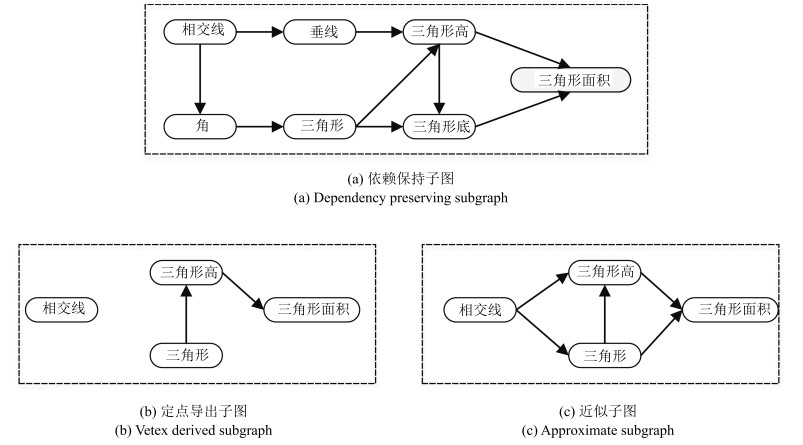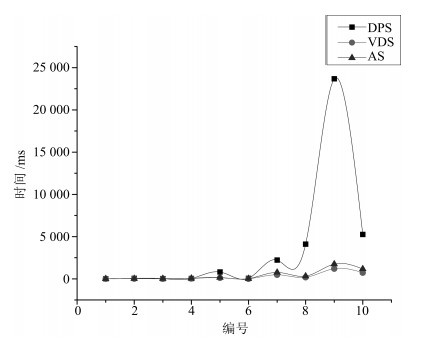-
摘要: 规则空间模型是一种高效的知识结构诊断模型,但较高的规则空间构造代价阻碍了在小规模、实时认知诊断中的应用.为了提高规则空间模型的可扩展性,提出使用近似子图生成理想属性模式集进而压缩规则空间的方法.近似子图能够通过忽略和测试项目无关的属性降低子图规模量级,从而有效缩减理想属性模式集规模,达到压缩规则空间的目的;同时通过构建顶点间的虚拟边模拟领域知识图上的传递依赖关系,使近似子图在不引入额外属性的前提下保持领域知识图上的依赖关系,实现对不合理属性模式的有效过滤.在此基础上,给出了构造规则空间所需的近似子图构造算法以及由近似子图生成理想属性模式集的方法.最后在标准测试集上开展了近似子图与依赖保持子图和顶点导出子图两种方法的性能对比实验,并将近似子图应用于实际教学认知诊断中验证其诊断准确率,实验结果表明近似子图能够在不损失诊断结果准确率的前提下显著压缩规则空间,降低规则空间模型应用于小规模、实时诊断的门槛.Abstract: Rule-space model is an effective method to diagnose knowledge structure of subjects. But high time cost of rule-space construction is a major obstacle to its application in the small and real time cognitive diagnosis. In order to improve the scalability of rule-space model, an algorithm is proposed to compress rule space by constructing an ideal attribute pattern set using the approximate subgraph. Approximate subgraph can decrease the order of subgraph by ignoring attributes unrelated to testing items so as to reduce the scale of ideal attribute set effectively, then the rule space can be compressed accordingly. At the same time, virtual edges between vertexes are constructed to simulate transitive dependencies on the domain knowledge graph, and these virtual edges preserve indirect dependences on the domain knowledge graph without introducing additional attributes, which ensures effective filteration of unreasonable attribute pattern. On this basis, the approximate graph construction algorithms and ideal attribute pattern generation algorithm supported by approximate subgraph are given for rule space construction. Finally, experiments for comparing the performance among approximate subgraph, dependency preserving subgraph and vertex derived subgraph on the benchmark dataset were carried out, followed by an application in practical teaching cognitive to verify the diagnosis accuracy of approximate subgraph based method. It is concluded that approximate subgraph compresses rule space remarkably without loss of diagnosis accuracy and makes it possible to apply rule space model to small and realtime cognitive diagnosis.
-
Key words:
- Rule space /
- approximate subgraph /
- dependency preserving /
- compression /
- ideal attribute pattern
1) 本文责任编委 王立威 -
表 1 测试项目及其对应的属性
Table 1 Test item and its attributes
属性 $q_1$ $q_2$ $q_3$ $q_4$ $q_5$ 相交线 $\surd $ $\surd $ 三角形 $\surd $ $\surd $ 三角形高 $\surd $ $\surd $ 三角形面积 $\surd $ 表 2 由$Q_{\rm sub}$生成的理想属性模式
Table 2 Ideal attribute pattern generated by $Q_{\rm sub}$
ID $m$ $L(m)$ 1 $0000$ {} 2 $1000$ {相交线} 3 $1100$ {相交线, 三角形} 4 $1110$ {相交线, 三角形, 三角形高} 5 $1111$ {相交线, 三角形, 三角形高, 三角形面积} 表 3 理想属性模式与期望反应模式的对应关系
Table 3 Expected response pattern corresponding to ideal attribute pattern
ID $m$ $L(m)$ $R(m)$ 1 $0000$ {} 00000 2 $1000$ {相交线} 10000 3 $1100$ {相交线, 三角形} 11000 4 $1110$ {相交线, 三角形, 三角形高} 11101 5 $1111$ {相交线, 三角形, 三角形高, 三角形面积} 11111 表 4 由VDS导出的理想属性模式集
Table 4 Ideal attribute set exported from VDS
ID $m$ $L(m)$ 1 $0000$ {} 2 $0100$ {三角形} 3 $0110$ {三角形, 三角形高} 4 $0111$ {三角形, 三角形高, 三角形面积} 5 $1000$ {相交线} 6 $1100$ {相交线, 三角形} 7 $1110$ {相交线, 三角形, 三角形高} 8 $1111$ {相交线, 三角形, 三角形高, 三角形面积} 表 5 第1组实验中子图及理想属性模式规模
Table 5 Scale of subgraphs and ideal attribute pattern in the first experiment
ID $|Q_{\rm sub}|$ $|K(Q_{\rm sub})|$ $|V|$ $|E|$ $|M|$ DPS VDS AS DPS VDS AS DPS VDS AS 1 5 4 5 4 4 6 2 5 14 11 5 2 5 6 9 6 6 13 3 7 134 31 16 3 6 5 6 5 5 8 3 6 28 18 9 4 6 7 10 7 7 13 4 9 195 54 26 5 10 9 13 9 9 18 5 11 802 156 82 6 11 7 11 7 7 15 4 9 258 49 24 7 12 15 19 15 15 29 11 20 4 836 763 392 8 15 11 17 11 11 23 7 14 6 751 538 262 9 17 14 20 14 14 28 9 18 19 735 3 365 1 144 10 17 12 19 12 12 27 7 15 9 754 1 044 393 表 6 第2组实验中子图及理想属性模式规模
Table 6 The scale of subgraphs and ideal attribute pattern in practical teaching cogonitive diagnosis in the second experiment
ID $|Q_{\rm sub}|$ $|K(Q_{\rm sub})|$ $|V|$ $|E|$ $|M|$ DPS VDS AS DPS VDS AS DPS VDS AS 1 6 6 10 6 6 13 4 5 130 28 19 2 6 6 8 6 6 10 4 5 44 31 18 3 6 5 8 5 5 10 3 5 43 20 11 4 6 6 10 6 6 14 4 6 126 28 19 5 7 7 11 7 7 15 4 8 210 60 29 6 8 7 10 7 7 13 5 6 135 49 32 7 7 8 13 8 8 17 5 8 763 102 48 8 8 6 9 6 6 12 4 7 76 27 15 表 7 诊断结果准确率
Table 7 Accuracy of diagnostic results
编号 Valid $H$(91~100 %) $M$(81~90 %) $L$(0~80 %) 1 49 89.38 8.01 2.61 2 51 92.79 5.03 2.18 3 50 88.09 8.38 3.53 4 51 95.13 3.62 1.25 5 53 90.43 6.72 2.85 6 52 86.11 9.22 4.67 7 53 85.23 9.81 4.96 8 55 94.91 3.31 1.78 -
[1] 石俊飞, 刘芳, 林耀海, 刘璐.基于深度学习和层次语义模型的极化SAR分类.自动化学报, 2017, 43(2): 215-226 http://www.aas.net.cn/CN/abstract/abstract19010.shtmlShi Jun-Fei, Liu Fang, Lin Yao-Hai, Liu Lu. Polarimetric SAR image classification based on deep learning and hierarchical semantic model. Acta Automatica Sinica, 2017, 43(2): 215-226 http://www.aas.net.cn/CN/abstract/abstract19010.shtml [2] 曾帅, 王帅, 袁勇, 倪晓春, 欧阳永基.面向知识自动化的自动问答研究进展.自动化学报, 2017, 43(9): 1491-1508 http://www.aas.net.cn/CN/abstract/abstract19126.shtmlZeng Shuai, Wang Shuai, Yuan Yong, Ni Xiao-Chun, Ouyang Yong-Ji. A survey on question answering systems towards knowledge automation. Acta Automatica Sinica, 2017, 43(9): 1491-1508 http://www.aas.net.cn/CN/abstract/abstract19126.shtml [3] 白天翔, 王帅, 沈震, 曹东璞, 郑南宁, 王飞跃.平行机器人与平行无人系统:框架、结构、过程、平台及其应用.自动化学报, 2017, 43(2): 161-175 http://www.aas.net.cn/CN/abstract/abstract18998.shtmlBai Tian-Xiang, Wang Shuai, Shen Zhen, Cao Dong-Pu, Zheng Nan-Ning, Wang Fei-Yue. Parallel robotics and parallel unmanned systems: framework, structure, process, platform and applications. Acta Automatica Sinica, 2017, 43(2): 161-175 http://www.aas.net.cn/CN/abstract/abstract18998.shtml [4] Hooshyar D, Ahmad R B, Yousefi M, Fathi M, Horng S J, Lim H. Applying an online game-based formative assessment in a flowchart-based intelligent tutoring system for improving problem-solving skills. Computers and Education, 2016, 94: 18-36 doi: 10.1016/j.compedu.2015.10.013 [5] Rau M A, Michaelis J E, Fay N. Connection making between multiple graphical representations: a multi-methods approach for domain-specific grounding of an intelligent tutoring system for chemistry. Computers and Education, 2015, 82: 460-485 doi: 10.1016/j.compedu.2014.12.009 [6] Duffy M C, Azevedo R. Motivation matters: interactions between achievement goals and agent scaffolding for self-regulated learning within an intelligent tutoring system. Computers in Human Behavior, 2015, 52: 338-348 doi: 10.1016/j.chb.2015.05.041 [7] 戴汝为, 张雷鸣.思维(认知)科学在中国的创新与发展.自动化学报, 2010, 36(2): 193-198 http://www.aas.net.cn/CN/abstract/abstract15990.shtmlDai Ru-Wei, Zhang Lei-Ming. The creation and development of noetic (cognitive) science in China. Acta Automatica Sinica, 2010, 36(2): 193-198 http://www.aas.net.cn/CN/abstract/abstract15990.shtml [8] Tatsuoka K K. Rule space: an approach for dealing with misconceptions based on item response theory. Journal of Educational Measurement, 1983, 20(4): 345-354 doi: 10.1111/j.1745-3984.1983.tb00212.x [9] 辛涛, 焦丽亚.测量理论的新进展:规则空间模型.华东师范大学学报(教育科学版), 2006, 24(3): 50-56, 61 doi: 10.3969/j.issn.1000-5560.2006.03.007Xin Tao, Jiao Li-Ya. A new perspective for testing theory: the rule-space model. Journal of East China Normal University (Educational Sciences), 2006, 24(3): 50-56, 61 doi: 10.3969/j.issn.1000-5560.2006.03.007 [10] Bernacki M L, Aleven V, Nokes-Malach T J. Stability and change in adolescents' task-specific achievement goals and implications for learning mathematics with intelligent tutors. Computers in Human Behavior, 2014, 37: 73-80 doi: 10.1016/j.chb.2014.04.009 [11] Gálvez J, Guzmán E, Conejo R, Mitrovic A, Mathews M. Data calibration for statistical-based assessment in constraint-based tutors. Knowledge-Based Systems, 2016, 97: 11-23 doi: 10.1016/j.knosys.2016.01.024 [12] Gutierrez F, Atkinson J. Adaptive feedback selection for intelligent tutoring systems. Expert Systems with Applications, 2011, 38(5): 6146-6152 doi: 10.1016/j.eswa.2010.11.058 [13] Shikatani B, Vas S N, Goldstein D A, Wilkes C M, Buchanan A, Sankin L S, Grant J E. Individualized Intensive treatment for obsessive-compulsive disorder: a team approach. Cognitive and Behavioral Practice, 2016, 23(1): 31-39 doi: 10.1016/j.cbpra.2014.09.002 [14] Özyurt Ö, Özyurt H. Learning style based individualized adaptive e-learning environments: content analysis of the articles published from 2005 to 2014. Computers in Human Behavior, 2015, 52: 349-358 doi: 10.1016/j.chb.2015.06.020 [15] Belcadhi L C. Personalized feedback for self assessment in lifelong learning environments based on semantic web. Computers in Human Behavior, 2016, 55: 562-570 doi: 10.1016/j.chb.2015.07.042 [16] Im S, Yin Y. Diagnosing skills of statistical hypothesis testing using the rule space method. Studies in Educational Evaluation, 2009, 35(4): 193-199 doi: 10.1016/j.stueduc.2009.12.004 [17] Xin T, Xu Z Y, Tatsuoka K. Linkage between teacher quality, student achievement, and cognitive skills: a rule-space model. Studies in Educational Evaluation, 2004, 30(3): 205 -223 doi: 10.1016/j.stueduc.2004.09.002 [18] Badaracco M, Martínez L. A fuzzy linguistic algorithm for adaptive test in intelligent tutoring system based on competences. Expert Systems with Applications, 2013, 40(8): 3073-3086 doi: 10.1016/j.eswa.2012.12.023 [19] Qin C Y, Zhang L, Qiu D L, Huang L, Geng T, Jiang H, Ren Q, Zhou J Z. Model identification and Q-matrix incremental inference in cognitive diagnosis. Knowledge-Based Systems, 2015, 86: 66-76 doi: 10.1016/j.knosys.2015.05.024 [20] 汪玲玲, 陈平, 辛涛, 衷克定.基于BP神经网络的认知诊断计算机化自适应测验实现.北京师范大学学报(自然科学版), 2015, 51(2): 206-211 http://d.old.wanfangdata.com.cn/Periodical/bjsfdxxb201502019Wang Ling-Ling, Chen Ping, Xin Tao, Zhong Ke-Ding. Realizing cognitive diagnostic computerized adaptive testing based on BP neural network. Journal of Beijing Normal University (Natural Science), 2015, 51(2): 206-211 http://d.old.wanfangdata.com.cn/Periodical/bjsfdxxb201502019 [21] Cui Y, Gierl M, Guo Q. Statistical classification for cognitive diagnostic assessment: an artificial neural network approach. Educational Psychology, 2016, 36(6): 1065-1082 doi: 10.1080/01443410.2015.1062078 [22] Bandyopadhyay S, Bhadra T, Mitra P, Maulik U. Integration of dense subgraph finding with feature clustering for unsupervised feature selection. Pattern Recognition Letters, 2014, 40: 104-112 doi: 10.1016/j.patrec.2013.12.008 [23] Cameron D, Kavuluru R, Rindflesch T C, Sheth A P, Thirunarayan K, Bodenreider O. Context-driven automatic subgraph creation for literature-based discovery. Journal of Biomedical Informatics, 2015, 54: 141-157 doi: 10.1016/j.jbi.2015.01.014 [24] Azimi S, Gratie C, Ivanov S, Petre I. Dependency graphs and mass conservation in reaction systems. Theoretical Computer Science, 2015, 598: 23-39 doi: 10.1016/j.tcs.2015.02.014 [25] Yap K C, Chia K P. Knowledge construction and misconstruction: a case study approach in asynchronous discussion using knowledge construction-message map (KCMM) and knowledge construction-message graph (KCMG). Computers and Education, 2010, 55(4): 1589-1613 doi: 10.1016/j.compedu.2010.07.002 [26] Baier C, Katoen J P. Principles of Model Checking. Cambridge: MIT Press, 2008. [27] Huang S B, Huang H T, Chen Z Y, Lv T Y, Zhang T. Lazy slicing for state-space exploration. Journal of Computer Science and Technology, 2012, 27(4): 872-890 doi: 10.1007/s11390-012-1271-7 [28] Akgün Ö. Extensible automated constraint modelling via refinement of abstract problem specifications. Constraints, 2017, 22(1): 91-92 doi: 10.1007/s10601-016-9258-6 [29] Pelechano N, Fuentes C. Hierarchical path-finding for Navigation Meshes (HNA*). Computers and Graphics, 2016, 59: 68-78 doi: 10.1016/j.cag.2016.05.023 [30] 张绍辉.集成参数自适应调整及隐含层降噪的深层RBM算法.自动化学报, 2017, 43(5): 855-86 http://www.aas.net.cn/CN/abstract/abstract19063.shtmlZhang Shao-Hui. Deep RBM algorithm with adaptive adjustment parameters and de-noising in hidden layer. Acta Automatica Sinica, 2017, 43(5): 855-865 http://www.aas.net.cn/CN/abstract/abstract19063.shtml -





 下载:
下载:





